Related Research Articles

A mural is any piece of graphic artwork that is painted or applied directly to a wall, ceiling or other permanent substrate. Mural techniques include fresco, mosaic, graffiti and marouflage.

The Mississippi River is the primary river of the largest drainage basin in the United States. From its traditional source of Lake Itasca in northern Minnesota, it flows generally south for 2,340 miles (3,766 km) to the Mississippi River Delta in the Gulf of Mexico. With its many tributaries, the Mississippi's watershed drains all or parts of 32 U.S. states and two Canadian provinces between the Rocky and Appalachian mountains. The river either borders or passes through the states of Minnesota, Wisconsin, Iowa, Illinois, Missouri, Kentucky, Tennessee, Arkansas, Mississippi, and Louisiana. The main stem is entirely within the United States; the total drainage basin is 1,151,000 sq mi (2,980,000 km2), of which only about one percent is in Canada. The Mississippi ranks as the world's tenth-largest river by discharge flow, and the largest in North America.
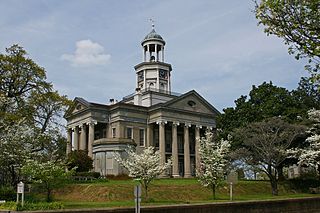
Vicksburg is a historic city in Warren County, Mississippi, United States. It is the county seat. The population was 21,573 at the 2020 census. Located on a high bluff on the east bank of the Mississippi River across from Louisiana, Vicksburg was built by French colonists in 1719. The outpost withstood an attack from the native Natchez people. It was incorporated as Vicksburg in 1825 after Methodist missionary Newitt Vick. The area that is now Vicksburg was long occupied by the Natchez Native Americans as part of their historical territory along the Mississippi. The first Europeans who settled the area were French colonists who built Fort Saint Pierre in 1719 on the high bluffs overlooking the Yazoo River at present-day Redwood. They conducted fur trading with the Natchez and others, and started plantations. During the American Civil War, it was a key Confederate river-port, and its July 1863 surrender to Ulysses S. Grant, along with the concurrent Battle of Gettysburg, marked the turning-point of the war.
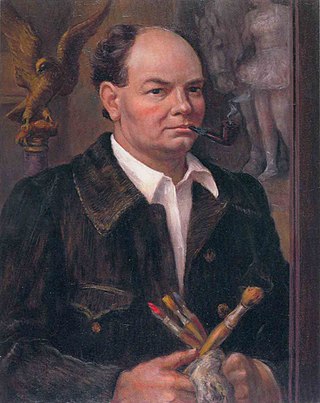
John Steuart Curry was an American painter whose career spanned the years from 1924 until his death. He was noted for his paintings depicting rural life in his home state, Kansas. Along with Thomas Hart Benton and Grant Wood, he was hailed as one of the three great painters of American Regionalism of the first half of the twentieth century. Curry's artistic production was varied, including paintings, book illustrations, prints, and posters.
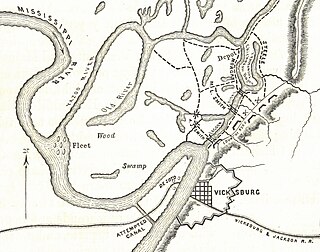
Grant's Canal was an incomplete military effort to construct a canal through De Soto Point in Louisiana, across the Mississippi River from Vicksburg, Mississippi. During the American Civil War, the Union Navy attempted to capture the Confederate-held city of Vicksburg in 1862, but were unable to do so with army support. Union Brigadier-General Thomas Williams was sent to De Soto Point with 3,200 men to dig a canal capable of bypassing the strong defenses around Vicksburg. Despite being assisted by locally enslaved people, Williams was unable to finish constructing the canal due to disease and falling river levels, and the project was abandoned until January 1863, when Union Major-General Ulysses S. Grant took an interest in the project.

The Great Wall of Los Angeles is a 1978 mural designed by Judith Baca and executed with the help of over 400 community youth and artists coordinated by the Social and Public Art Resource Center (SPARC). The mural, on the concrete sides of the Tujunga Wash in the San Fernando Valley was Baca's first mural and SPARC's first public art project. Under the official title of The History of California, it was listed on the National Register of Historic Places in 2017.

On Monday, August 29, 2005, there were over 50 failures of the levees and flood walls protecting New Orleans, Louisiana, and its suburbs following passage of Hurricane Katrina. The failures caused flooding in 80% of New Orleans and all of St. Bernard Parish. In New Orleans alone, 134,000 housing units—70% of all occupied units—suffered damage from Hurricane Katrina and the subsequent flooding.

Anton Refregier was a painter and muralist active in Works Progress Administration Federal Art Project commissions, and in teaching art. He was a Russian immigrant to the United States.

The Detroit Industry Murals (1932–1933) are a series of frescoes by the Mexican artist Diego Rivera, consisting of twenty-seven panels depicting industry at the Ford Motor Company and in Detroit. Together they surround the interior Rivera Court in the Detroit Institute of Arts. Painted between 1932 and 1933, they were considered by Rivera to be his most successful work. On April 23, 2014, the Detroit Industry Murals were designated by the Department of Interior as a National Historic Landmark.
The Flood Control Act of 1928 authorized the United States Army Corps of Engineers to design and construct projects for the control of floods on the Mississippi River and its tributaries as well as the Sacramento River in California. It was sponsored by Senator Wesley L. Jones (R) of Washington and Representative Frank R. Reid (R) of Illinois, in response to the Great Mississippi Flood of 1927.
Herb Roe is a painter of large-scale outdoor murals and classical realist oil paintings. After attending the Columbus College of Art and Design in Columbus, Ohio for a short time, he apprenticed to mural artist Robert Dafford. After 15 years with Dafford Murals, Roe left to pursue his own art career. He currently resides in Lafayette, Louisiana.
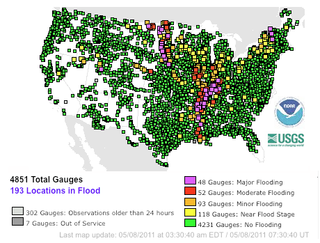
Major floods along the Mississippi River in April and May 2011 were among the largest and most damaging recorded along the U.S. waterway in the past century, comparable in extent to the Great Mississippi Flood of 1927 and Great Flood of 1993. In April 2011, two large storm systems deposited record levels of rainfall on the Mississippi River drainage basin. When that additional water combined with the springtime snowmelt, the river and many of its tributaries began to swell to record levels by the beginning of May. Flooding occurred in Illinois, Missouri, Kentucky, Tennessee, Arkansas, Mississippi, and Louisiana.

The Mississippi River Basin Model was a large-scale hydraulic model of the entire Mississippi River basin, covering an area of 200 acres. It is part of the Waterways Experiment Station, located near Clinton, Mississippi. The model was built from 1943 to 1966 and in operation from 1949 until 1973. By comparison, the better known San Francisco Bay Model covers 1.5 acres and the Chesapeake Bay Model covers 8 acres. The model is now derelict, but open to the public within Buddy Butts Park, Jackson.
One Hundred Years: History of the Chinese in America is a 1952 mural painting by James Leong.
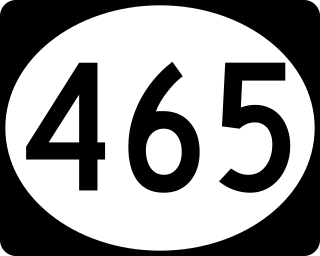
Mississippi Highway 465 is a highway in the southern region of the Mississippi Delta. The highway starts at U.S. Route 61 near Redwood. It travels westward towards the Mississippi River, and then northwards to the village of Eagle Bend. The highway then traverses on the Mississippi River levee on a one-lane road. Later, MS 465 leaves the levee, continues northward, and soon ends at MS 1.

Victor Mikhail Arnautoff was a Russian-American painter and professor of art. He worked in San Francisco and the Bay Area from 1925 to 1963, including two decades as a teacher at Stanford University, and was particularly prolific as a muralist during the 1930s. He became a naturalized U.S. citizen, but returned to the Soviet Union after the death of his wife, continuing his career there before his death.
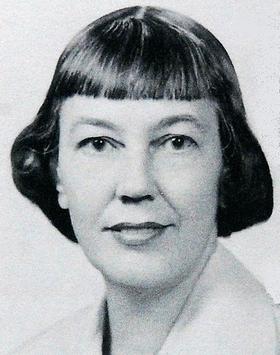
Tracy Montminy, who completed early works as Elizabeth Tracy, (1911–1992) was an American artist and muralist. During the WPA's era, she painted murals in civic buildings, including murals in the library in Cambridge, Massachusetts; the fire and police building of Saugus, Massachusetts; the Milton, Massachusetts, post office; Medford, Massachusetts City Hall; the post office of Downers Grove, Illinois; and the post office in Kennebunkport, Maine, as well as others both in the U.S. and abroad. She was an art instructor at the University of Missouri and the American University of Beirut, continuing her own painting projects simultaneously with her teaching into the 1980s. Upon her death, she established a trust to create the Montminy Art Gallery in Columbia, Missouri.

Flooding in the Mississippi River Basin during the winter, spring, and summer of 2019 caused at least 12 deaths and economic losses in 19 states totaling in excess of $20 billion. Estimated damages in the Midwestern United States alone had reached $12.5 billion by April 2019. Flood damages totaling $6.2 billion were reported in the 11 states bordering the Mississippi River. In addition to property and crop losses and infrastructure damages, commercial navigation on the Mississippi River was interrupted repeatedly by high currents, low bridge clearances, and closed locks. This delayed shipments of agricultural commodities, adding to the economic stress of crop losses caused by flooding. As of late April 2019, shipments of corn to export terminals in Louisiana were 31% lower than in same period in 2018.

In 1941, Anton Refregier won the $26,000 commission for the series History of San Francisco, which are a set of 27 murals painted in the lobby of the Rincon Annex Post Office in San Francisco, California. Refregier painted the mural with casein tempera on white gesso over plaster walls, in the social realism style. Work was interrupted by World War II and restarted in 1946; the murals were completed in 1948.
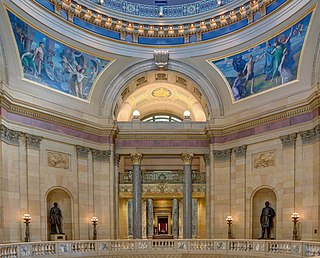
The Minnesota State Capitol opened in 1905 with roughly 60 artworks that totaled $300,000, or 7% of the $4.5-million project budget. Cass Gilbert, the architect of the Capitol building, had envisioned that the artworks would add "educational value" and provide for the "advancement of civilization and intelligence." Over the years, more artworks would be added to the Capitol, totaling nearly 150 by 2017. Much of the Capitol art is allegorical, as expressed through murals and sculptures, while some feature key moments in Minnesota history. While the allegorical symbolism used in the paintings would have been more widely understood during the time they were painted, over time the meanings have been challenged.